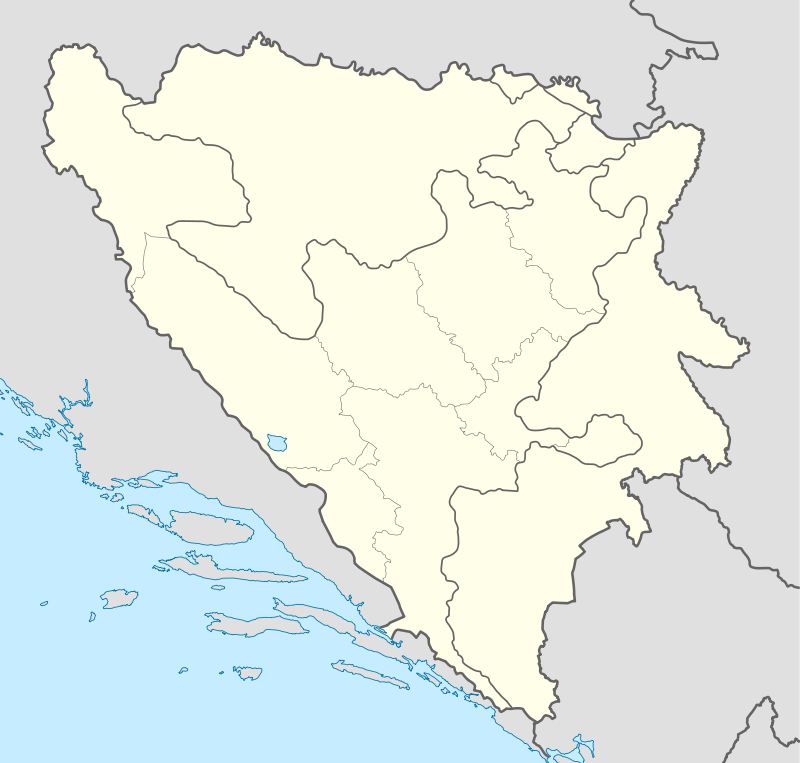Bugojno
| Bugojno Бугојно | |
|---|---|
| Municipality and town | |
.jpg) | |
 Location of Bugojno within Bosnia and Herzegovina. | |
 Bugojno Location of Bugojno | |
| Coordinates: 44°03′N 17°27′E / 44.050°N 17.450°ECoordinates: 44°03′N 17°27′E / 44.050°N 17.450°E | |
| Country | Bosnia and Herzegovina |
| Government | |
| • Municipality president | Hasan Ajkunić (SDA) |
| Area | |
| • Total | 361 km2 (139 sq mi) |
| Population (2013[1]) | |
| • Total | 34,559 |
| • Density | 96/km2 (250/sq mi) |
| Time zone | CET (UTC+1) |
| • Summer (DST) | CEST (UTC+2) |
| Area code(s) | +387 30 |
| Website | Official Website |
Bugojno is a town and municipality in central Bosnia and Herzegovina, situated by the river Vrbas. It is located in the Central Bosnia Canton of the Federation of Bosnia and Herzegovina entity. The town is 130 km (81 mi) to the northwest from Sarajevo. Before the war, it was a multi-ethnic town, now predominantly Bosniak.
To the west towards Kupres is a region called Koprivica. This enormous forest was once one of President Tito's favorite hunting spots. The uninhabited dense forest has created a sanctuary for wild animals. Hunting associations are very active in this region and there are many mountain and hunting lodges dotting the forest. Duboka Valley (deep valley) is a designated hunting area covered by thick spruce. Kalin Mountain is a popular weekend area for hikers and nature lovers.
Geography
The municipality of Bugojno has an average elevation of 570 meters above sea level. Much of its 366 km2 is forested. The terrain is mountainous with several prominent features. Stozer (1662m), Kalin (1,530m) and Rudina (1,385m) are the tallest mountains in Bugojno.
Demographics
The town and municipality is inhabited by a Bosniak majority. The town, prior to the war, was multi-ethnic, with virtually identical numbers of Croats, Bosniaks and Serbs. Today, only an estimated 150 Serbs live in the town, while ca. 200 in the municipality.[2][3] The number of Croats in the municipality has gone down from 16,500 to ca. 4,500 (2008).[4]
Town
In 1991 town of Bugojno had a population of 22, 641 including;
Municipality
| Ethnic Composition | |||||||||||||
| Year | Serbs | % | Bosniaks | % | Croats | % | Yugoslavs | % | Others | % | Total | ||
|---|---|---|---|---|---|---|---|---|---|---|---|---|---|
| 1961 | 5,212 | 21.61% | 7,194 | 29.83% | 9,682 | 40.15% | 1,871 | 7.76% | 155 | 0.64% | 24,114 | ||
| 1971 | 6,295 | 19.76% | 13,050 | 40.96% | 12.040 | 37.79% | 197 | 0.61% | 274 | 0.88% | 31,856 | ||
| 1981 | 7,458 | 18.65% | 16,214 | 40.56% | 14,187 | 35.49% | 1,731 | 4.33% | 379 | 0.97% | 39,969 | ||
| 1991 | 8,673 | 18.50% | 19,697 | 42.01% | 16,031 | 34.19% | 1,561 | 3.33% | 927 | 1.98% | 46,889 | ||
Economy
Bugojno was once a major industrial center in Bosnia and Herzegovina. In 1981, Bugujno's GDP per capita was 98% of the Yugoslav average.[5] However, hardships caused by the war in Bosnia and Herzegovina took a toll on the industry and overall economy of Bugojno. Apart from industry, forestry has been an important contributor to the local economy and continues to be. In recent years, agriculture has grown in sustaining the Bugojno's economy as many people are investing in land and agronomy.
Gallery
- Center of the city
- Center of the city
- High school
- Ski lift Rostovo
- Princess Gevher mosque
- Princess Gevher mosque
- Sultan Ahmed mosque, 1693
- Sultan Ahmed mosque, 1693
- Sultan Ahmed mosque, 1693
- Sultan Ahmed mosque, 1693
- Sultan Ahmed mosque, 1693
- Catholic church of Saint Anthony of Padua
- Catholic church of Saint Anthony of Padua
- Catholic church of Saint Anthony of Padua and Princess Gevher mosque in background
- Catholic church of Saint Anthony of Padua
Notable people
- Željko Bebek (1945-), singer
- Branko Mikulić (10 June 1928 – 12 April 1994), Prime Minister of Yugoslavia (15 May 1986 - 16 March 1989), President of Organizing Committee for Winter Olympic Games 1984
- Stjepan Domaćinović Kokan (1931 - 2009) The politician, a local patriot and a successful businessman.
- Ivona Dadić (1993-), Austrian heptathlete of Croatian descent
- Zenit Đozić (1961-), actor and humorist
- Vlatko Markovic (1937-2013), former footballer and manager
- Ermin Zec (1988-), footballer
References
- ↑ http://www.bhas.ba/obavjestenja/Preliminarni_rezultati_bos.pdf
- ↑ "BUGOJNO: I Bog i svijet znaju da su Vučići pravoslavci!". Bugojno danas. 2015.
- ↑ "BiH: Bugojno opština bez Srba". Novosti. 2014.
- ↑ "Izumiru bugojanski Hrvati i Srbi". Nezavisne. 2008.
- ↑ Radovinović, Radovan; Bertić, Ivan, eds. (1984). Atlas svijeta: Novi pogled na Zemlju (in Croatian) (3rd ed.). Zagreb: Sveučilišna naklada Liber.
External links
| Wikimedia Commons has media related to Bugojno. |